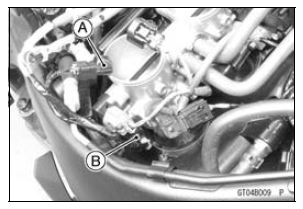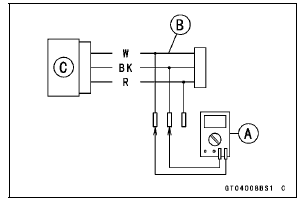

Disconnect the throttle sensor setting adapter [A] from the connector of the main harness side.
Special Tool - Throttle Sensor Setting Adapter: 57001 -1538
Connect the setting adapter [B] to the sensor connector only.
Connect a digital meter [A] to the setting adapter [B].
Main Throttle Sensor [C]

Main Throttle Sensor Resistance
Connections to Adapter:
W (sensor BL) lead ← → BK (sensor BR/BK) lead
Standard: 4 6 kΩ
6 kΩ

If the reading is out of the standard, replace the throttle body assy.
If the reading is within the standard, check the output voltage (see Main Throttle Sensor Output Voltage Inspection).
 Main Throttle Sensor Input Voltage Inspection
Main Throttle Sensor Input Voltage Inspection Main Throttle Sensor Output Voltage Inspection
Main Throttle Sensor Output Voltage InspectionRear Wheel Rotation Sensor Signal Abnormal (Service Code b 44)
Measure the air gap between the rear wheel rotation sensor
and sensor rotor.
Thickness Gauge [A]
Air Gap
Standard: 0.4 1.6 mm (0.02
0.06 in.)
If the measurement is not the standard, check each part
for deformation and looseness and correct accordingly.
If the measurement is the sta ...
Piston Ring, Piston Ring Groove Wear Inspection
Check for uneven groove wear by inspecting the ring seating.
The rings should fit perfectly parallel to groove surfaces.
If not, replace the piston and all the piston rings.
With the piston rings in their grooves, make several measurements
with a thickness gauge [A] to determine pisto ...
Tire Installation
WARNINGSome replacement tires may adversely
affect handling
and cause an accident resulting in serious injury
or death. To ensure proper handling and stability,
use only the recommended standard tires for
replacement, inflated to the standard pressure.
Inspect the rim ...